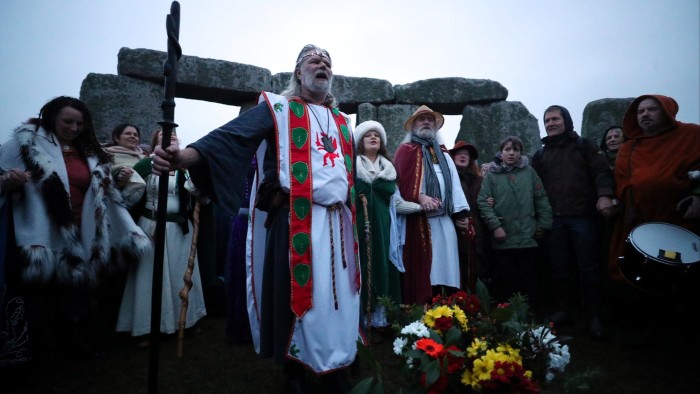Unlock the Editor’s Digest for free
Roula Khalaf, Editor of the FT, selects her favourite stories in this weekly newsletter.
A few years ago a friend of mine suggested an adventure. Did anyone, she asked, want to try visiting Stonehenge for the winter solstice?
We did. A group of us convened in the small hours for the drive down from London to Wiltshire. Having failed to anticipate the traffic caused by thousands of people on the same mission, we had to abandon the car by the side of a country lane and run miles to reach the stone circle just in time for dawn.
Something about this absurd venture left everyone on a high, and so it became a regular fixture. It can be hard to explain to others why we get up horribly early and compete for parking spaces to attend an occasion where the sunrise may be entirely hidden by clouds and drizzle. Yet each year, we put circles of ivy on our heads and drink coffee at the visitors’ centre café before walking to the stones alongside druids in robes, families in tracksuits, musicians, Morris dancers, ravers, tourists, hippies, a Green Man or two and usually at least a couple of people wearing worryingly realistic horses’ heads.
Stonehenge was constructed roughly 5,000 years ago and its stones frame the summer sunrise and the winter sunset. For those dates only, English Heritage allows full access and people crowd into and around the stone circle; drumbeats, chanting and the singing of a robed female choir known as the Red Ladies build to a burst of cheers at dawn.
“When I stand in the circle at sunrise and hail the Sun and the Earth, I know that others have done it for thousands of years at that very place,” says King Arthur Pendragon, a senior druid, pagan priest and head of the Loyal Arthurian War Band.
Pendragon (formerly known as John Rothwell) is a 71-year-old motorbiker and eco-warrior who has repeatedly gone to court for access to the stones. He says celebrations at Stonehenge and other stone circles honour the annual cycle, known to pagans as the “turning of the wheel”. He and Rollo Maughfling, archdruid of Stonehenge and Britain, are among multiple pagan figures who lead ceremonies there.
But the event is sprawling and amorphous. Outside the stone circle, groups conduct improvised rituals, sing, dance, light incense and commune with the stones and Salisbury Plain.
Numbers topped 30,000 for the summer solstice before new restrictions — including an alcohol ban and parking charges — were introduced in 2016; last year about 15,000 people visited, while the winter solstice attracts 5,000. Other ancient sites, such as nearby Avebury and Castlerigg in the Lake District, also draw crowds.
“One reason why Stonehenge is so popular is that in a religious or a moral sense, everyone owns it . . . it’s a people’s temple. And all the lesser prehistoric monuments have the same kind of charge to them,” says Ronald Hutton, professor of history at Bristol university, who studies ancient and modern paganism.
All the signs point to pagan practices increasing. In England and Wales, some 74,000 people went so far as to list paganism as their religion in the 2021 census, up almost 30 per cent from a decade earlier.
There are covens and moots, witches’ Discord servers, pagan Instagram influencers and Facebook groups. Hutton points to the informality of modern pagan practice as one of its attractions. “It’s a private religion with no institutional basis. People choose to do it in their own front rooms, bedrooms and gardens.”
For many more of us, the benign chaos of the solstice and the ancient solidity of stones are a consoling combination. This Saturday I will spend the summer solstice camping near the Avebury stone circles with my seven-year-old son, who shows a promising interest in the ancient and uncanny.
Little is known about the actual practices of those who built Britain’s Neolithic stone circles, but Pendragon points to the prehistoric charred animal remains found nearby: essentially, the remains of large pig barbecues, a sign of both festivity and faith in the future to provide more food.
“They slaughtered all their pigs and that was a leap of faith,” he says. “They put their faith in nature and in the turning of the wheel.”
